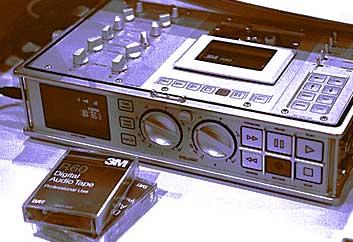|
Module 44 - B |
Updated: 08/13/2005 |
|
Audio Recording,
|
|
DATs
(digital audio tapes) are capable of audio quality that exceeds what's possible
with CDs. The 2-inch by 2-7/8 inch (5 X 7.6 cm) DAT cassette contains audio tape
3.81mm wide. The cassette (shown below) is about two-thirds the size of
a standard analog audiocassette. The two-hour capacity of a DAT cassette is 66 percent
greater than a standard 80-minute CD. RDAT (recordable digital audio tape) is designed for professional applications, as are the very high quality ADAT machines (types I and II). DAT systems use a headwheel that spins at 2,000 rpm (revolutions per minute), similar to what's found in a videocassette recorder. Various types of data can be recorded with the audio. Examples are time code and the MIDI machine control data used in sophisticated postproduction audio work.
The DAT time code system, referred to as the IEC Sub-code Format, also insures that tapes recorded on one DAT machine can be played back without problems on any other machine. DAT time code is similar to the SMPTE time code that we'll discuss in the sections on videotape editing.
Today, computer hard drives are the choice for broadcast music, commercials, and general audio tracks. Recording audio material on computer hard drives (generally with MPEG-2 compression, see below) has several advantages. First, the material can be indexed in a kind of "table of contents" that makes it easy to find what you need. This index can also list all of the relevant data about the "cuts" (selections): durations, artists, etc. Second, you have almost instant access to the selections. Once recorded on a hard drive, there is no wear and tear on the recording medium as the audio tracks are repeatedly played. Another advantage is that the selections can't be accidentally misfiled after use. (If you've ever put a CD back in the wrong case, you know the problems this can represent.) And, finally, the hard drive space can easily be erased and re-used.
Although hard drives are extremely reliable today, they do occasionally "crash," especially after thousands of hours of use, or a major jolt ends up damaging the delicate drive mechanism. Unless
In either case the files can be transferred directly to a PC for editing. The PC cards contain no moving parts and are impervious to shock and temperature changes. These units typically give you the choice of two recording formats:
MPEG, a compressed data format, and PCM (pulse code modulation) which is an uncompressed
digital format. The latter is used with CD players, DAT recorders, and on computer
editing programs that use wave (.wav) files.
RAM Audio Recorders As shown on the right, this new generation of recorders can be a fraction of the size of other types of recorders. However, unlike recorders with removable media, the stored audio must be played back from the unit, itself. For this reason these recorders have found limited acceptance in production work.
Audio editing used to require physically cutting and splicing audio tape—an arduous process at best. Today, there are numerous In addition to basic editing, audio editing programs offer audio filtering, manipulation, and an endless range of special audio effects.
The audio line above shows how a single channel of sound appears in an audio editor. The vertical red line indicates the cursor position. Much as a cursor is used to mark words in a word processing program to make changes as needed, the cursor in an audio time line provides a point of reference for making audio changes.
Audio editing in television production is typically handled along with the video on a video editing system. This will be covered in more detail in Module 56. The hard drives on computer-based audio editing systems can also store a wide range of sound effects that can be pulled down to a time line to accompany narration and music. |


 Some
audio production is now being done with PC card and IC recorders. Both use solid-state
memory cards, such as CompactFlash and ATA Cards.
Some
audio production is now being done with PC card and IC recorders. Both use solid-state
memory cards, such as CompactFlash and ATA Cards.
 computer-based
audio editing programs available. Many are shareware that can be downloaded from
the Internet. (Shareware can be downloaded and tested, generally for about a month,
before it quits working and you need to pay for it. Payment is generally between
5 and 50 dollars. Once you pay, you may be given an unlock code that will enable
you to use the program for an unlimited time. Often, updates to the program will
be free.)
computer-based
audio editing programs available. Many are shareware that can be downloaded from
the Internet. (Shareware can be downloaded and tested, generally for about a month,
before it quits working and you need to pay for it. Payment is generally between
5 and 50 dollars. Once you pay, you may be given an unlock code that will enable
you to use the program for an unlimited time. Often, updates to the program will
be free.)